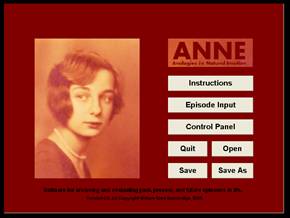Strategies for Personality Transfer
William Sims Bainbridge
page 10 of 15
A convenient way to record autobiographical memories is to carry around a PDA or pocket computer, and write them down at moments of inactivity during the day. A person can fully describe an episodic memory in one written paragraph. Any more complex narrative may link together several episodes or scripts, including  connected episodes that occur in a short period of time like scenes in a one-act drama. For example, a script for washing clothing connects to one for drying the clothes which connects to one for putting clean, dry clothing on hangers in the closet. Some people have a tendency when writing an episodic memory to add all kinds of explanatory material from semantic memory, but the one-paragraph rule applies to the episodic memory itself. It is said that each episode contains a memory of time and of space, but this is not quite true. Episodic memories often include a spatial image of location and the direction one is facing, along with the relative locations of objects or people. They do not carry a time stamp, however, and it is often possible to say within a few inches where an episode took place, but not know within a decade when.
connected episodes that occur in a short period of time like scenes in a one-act drama. For example, a script for washing clothing connects to one for drying the clothes which connects to one for putting clean, dry clothing on hangers in the closet. Some people have a tendency when writing an episodic memory to add all kinds of explanatory material from semantic memory, but the one-paragraph rule applies to the episodic memory itself. It is said that each episode contains a memory of time and of space, but this is not quite true. Episodic memories often include a spatial image of location and the direction one is facing, along with the relative locations of objects or people. They do not carry a time stamp, however, and it is often possible to say within a few inches where an episode took place, but not know within a decade when.
Autobiographical memories carry emotion or can be described in terms of the emotions that were probably involved.[1] Thus, for my current research on autobiographical memories I have created the software system I call ANNE (ANalogies in Natural Emotions) in terms of 20 emotions: anger, boredom, desire, disgust, excitement, fear, frustration, gratitude, hate, indifference, joy, love, lust, pain, pleasure, pride, sadness, satisfaction, shame, surprise.

Image 7: A screenshot of Bainbridge’s “Anne” program
Built into the system are 4,000 emotion-eliciting stimuli, including many events that relate to scripts most people have in their minds, such as: not being able to breathe, being at the top of a very tall building, being confined in a small space. The respondent rates each of these situations in terms of how much it might elicit each of the 20 emotions in him or her. The person also writes out 1,000 autobiographical memories and rates them in the same way.
Traditional diaries and contemporary blogs can both be tools for recording stream of consciousness over the life course, as can the computerized systems being developed by Bell, Wactlar and Mann. One advantage of recording autobiographical memories is that they are a sample of the past events that really matter to the individual, rather than a roster of everything that ever happened. Depth psychology, whether psychoanalytic or of some more modern sort, can identify developmental influences and connections to the immediate surroundings (microenvironment) or the wider world (macroenvironment). An especially powerful way of relating the social environment to the individual person is to archive simultaneously all the members of a family plus close friends, ideally an entire community. Clearly, how two lives intertwine can be an important dynamic for both of them.
Accuracy and Realism
Given all the many ways of measuring a person’s actions, reactions, and physical characteristics, one may wonder how much information is enough. Clearly, the answer will depend to some extent upon one’s philosophical orientation toward human personality, and upon one’s immediate practical goal. Borrowing a term from linguistics, we might say this is the question of pragmatics, concerning the relationship between what the person has to express and the expressions we have so far captured. Pragmatically, we need to balance accuracy of personality capture against the realistic cost of going beyond the point of diminishing returns.
Footnote
1. Zaionc, Robert B. 1998. “Emotions,” pp. 591-632 in The Handbook of Social Psychology, edited by Daniel T. Gilbert, Susan T. Fiske, and Gardner Lindzey. New York: McGraw-Hill.
(back to top)